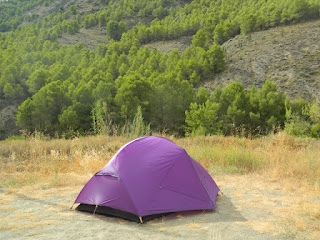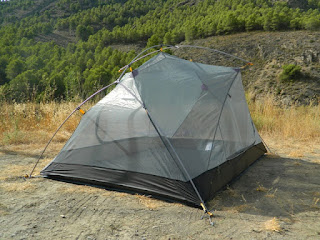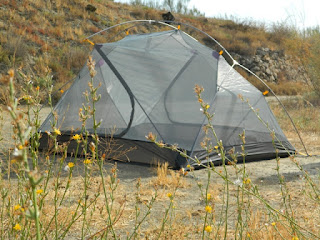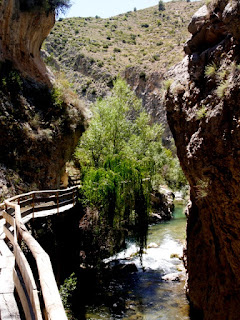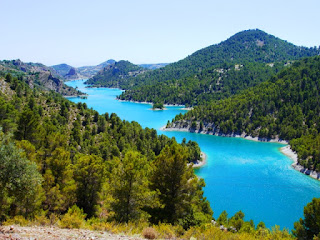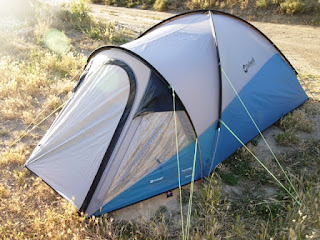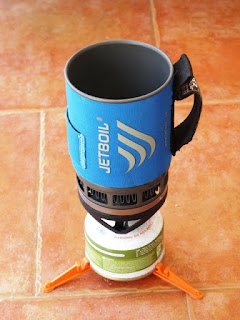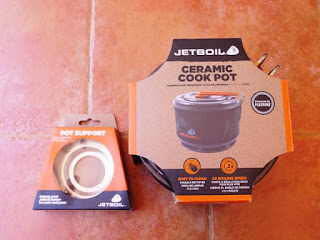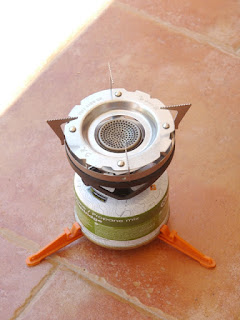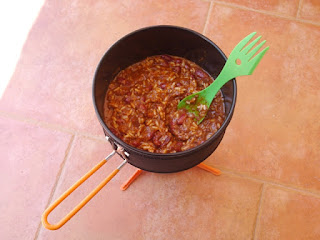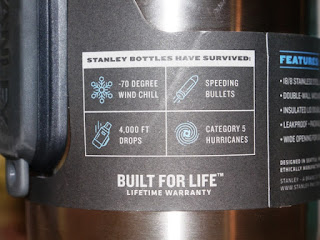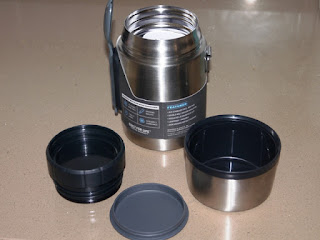I'm really not a fan of airbeds/mats; I wriggle a lot in the night and I find them a bit bouncy. The wife wriggles even more than me, and after a recent trip where I spent most of the night being bounced up and down every time she re-enacted River Dance in her sleep, I decided we needed a better alternative. And as you may have gathered, I'm a fan of self-inflating mats.
It's surprising just how few self-inflating double sleeping mats are available, and of those that do exist, even fewer are readily available here in Spain. Fortunately, one of those that was easy to get hold of - and for a very reasonable price - was the Outwell Sleepin Double.
The Sleepin Double is available in three thicknesses - 3cm, 5cm and 7.5cm. I went for the 3cm due to the combination of size, weight and price. I'm used to sleeping on 3cm mats so it seemed perfectly adequate for my needs. I have several Outwell products and have always found the quality to be very good, and first impressions of the mat were very positive; it comes with a storage bag and compression straps to help squeeze the mat down and keep it there when packing away, and the cover is good quality and seems like it will be hard-wearing.
The mat is effectively two single mats joined in the middle, and the join functions as a hinge so that the mat can also be used as a 6cm single mat - a nice touch. Both sides of the mat have their own valve so they can be tailored individually (by way of the amount of additional air blown in) to suit each person, and I was pleasantly surprised at how much the mat actually does self-inflate (there's a reason for this which I'll come back to), and it actually needed very little in the way of topping up. So far so good.
Packing it away, however, isn't the easiest task; over four-or-five attempts, I haven't been able to get the mat to roll properly - it always seems to want to twist as I get to the last quarter or so, no matter how carefully I roll it and ensure the two long edges are parallel. Fortunately the included storage bag is fairly roomy, and given that this isn't the kind of mat you would be taking wild camping, thus trying to force into a rucksack, it isn't the end of the world if it doesn't pack down as neatly as it should.
Now, to come back to why the mat self-inflates so quickly; many (if not most) self-inflating mats - particularly the ultralight mats I am used to using - use die-cut foam as the filler. Basically, in order to keep the weight down, the foam is not a solid slab, but has sections cut out of it. This also allows them to pack down to a compact size. Consequently, however, they generally need a good "topping up" via the valve as more air is required to "fill the gaps". The Outwell Sleepin Double is essentially just a slab of foam, hence why it pretty much inflates itself. Now because of this it is both heavier and bulkier (when packed) than it needs to be, though as mentioned this isn't a hiking mat so that isn't necessarily an issue.
What is an issue - and one that I never considered beforehand - is that the additional air in the die-cut mats actually provides a lot of cushioning and therefore comfort. So not only is the Sleepin Double less comfortable by comparison, it is without a doubt the least comfortable mat both myself and my wife have ever used. And I can't understate that. We both suffered a terrible night's sleep and woke next morning (if you can call it waking, after never really being able to get to sleep) with aching hips and backs. While admittedly I haven't tried it doubled-up in "single mode" (and there is very little argument for doing so on my part, given the single mats I already have), I would never use this mat as a double mat ever again. I would go so far as to say it isn't fit for purpose, if its purpose is to provide a comfortable night's sleep.
Now I appreciate everyone has different perspectives of "comfort", hence why there are so many choices of regular bed mattresses, but generally-speaking I'm not that picky - I've had a good night's sleep in an empty bathtub before - so for me to say it's uncomfortable is not a good sign. And it's a shame, because it's an otherwise well-priced, quality product in an under-saturated market; Outwell could have cleaned up here. But instead they dropped the ball, didn't do enough R&D and seemed to think sticking a slab of foam in a cover was sufficient - and it isn't.
So while I can't speak for the 5cm and 7.5cm variants - which arguably should offer a higher degree of comfort - I cannot possibly recommend the 3cm model, and would go so far as to say avoid it completely. There are far better options (albeit in the form of two single mats as opposed to one double mat) assuming comfort and a good night's sleep - and not convenience - are your priority.
Outwell Sleepin Double 3cm Self-Inflating Mat
NOTE: Outwell also make single versions of the Sleepin mats, which presumably used the same solid slab of foam. So again, on this basis I would avoid the 3cm version - there are much better mats of this thickness and in a similar price range.

